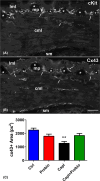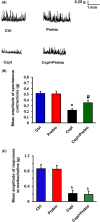Prebiotics counteract the morphological and functional changes secondary to chronic cisplatin exposition in the proximal colon of mice
- PMID: 38445787
- PMCID: PMC10915824
- DOI: 10.1111/jcmm.18161
Prebiotics counteract the morphological and functional changes secondary to chronic cisplatin exposition in the proximal colon of mice
Abstract
Cisplatin is an antimitotic drug able to cause acute and chronic gastrointestinal side effects. Acute side effects are attributable to mucositis while chronic ones are due to neuropathy. Cisplatin has also antibiotic properties inducing dysbiosis which enhances the inflammatory response, worsening local damage. Thus, a treatment aimed at protecting the microbiota could prevent or reduce the toxicity of chemotherapy. Furthermore, since a healthy microbiota enhances the effects of some chemotherapeutic drugs, prebiotics could also improve this drug effectiveness. We investigated whether chronic cisplatin administration determined morphological and functional alterations in mouse proximal colon and whether a diet enriched in prebiotics had protective effects. The results showed that cisplatin caused lack of weight gain, increase in kaolin intake, decrease in stool production and mucus secretion. Prebiotics prevented increases in kaolin intake, changes in stool production and mucus secretion, but had no effect on the lack of weight gain. Moreover, cisplatin determined a reduction in amplitude of spontaneous muscular contractions and of Connexin (Cx)43 expression in the interstitial cells of Cajal, changes that were partially prevented by prebiotics. In conclusion, the present study shows that daily administration of prebiotics, likely protecting the microbiota, prevents most of the colonic cisplatin-induced alterations.
Keywords: Connexin 43; choline acetyl-transferase (ChAT); interstitial cells of Cajal; methacholine; mucus secretion, PGP9.5; spontaneous contractile activity.
© 2024 The Authors. Journal of Cellular and Molecular Medicine published by Foundation for Cellular and Molecular Medicine and John Wiley & Sons Ltd.
Conflict of interest statement
The authors declare no conflict of interest.
Figures







Similar articles
-
GLP-2 Prevents Neuronal and Glial Changes in the Distal Colon of Mice Chronically Treated with Cisplatin.Int J Mol Sci. 2020 Nov 23;21(22):8875. doi: 10.3390/ijms21228875. Int J Mol Sci. 2020. PMID: 33238628 Free PMC article.
-
Glucagon-like peptide 2 counteracts the mucosal damage and the neuropathy induced by chronic treatment with cisplatin in the mouse gastric fundus.Neurogastroenterol Motil. 2016 Feb;28(2):206-16. doi: 10.1111/nmo.12712. Epub 2015 Nov 6. Neurogastroenterol Motil. 2016. PMID: 26547262
-
High-Fat Diet Enriched with Bilberry Modifies Colonic Mucus Dynamics and Restores Marked Alterations of Gut Microbiome in Rats.Mol Nutr Food Res. 2019 Oct;63(20):e1900117. doi: 10.1002/mnfr.201900117. Epub 2019 Aug 12. Mol Nutr Food Res. 2019. PMID: 31336403
-
Prebiotic effects: metabolic and health benefits.Br J Nutr. 2010 Aug;104 Suppl 2:S1-63. doi: 10.1017/S0007114510003363. Br J Nutr. 2010. PMID: 20920376 Review.
-
Food-based strategies to modulate the composition of the intestinal microbiota and their associated health effects.J Physiol Pharmacol. 2009 Dec;60 Suppl 6:5-11. J Physiol Pharmacol. 2009. PMID: 20224145 Review.
Cited by
-
Chemotherapy-Induced Neuropathy Affecting the Gastrointestinal Tract.Neurogastroenterol Motil. 2025 Aug;37(8):e14976. doi: 10.1111/nmo.14976. Epub 2024 Dec 9. Neurogastroenterol Motil. 2025. PMID: 39651634 Free PMC article. Review.
-
The Possible Involvement of Glucagon-like Peptide-2 in the Regulation of Food Intake through the Gut-Brain Axis.Nutrients. 2024 Sep 11;16(18):3069. doi: 10.3390/nu16183069. Nutrients. 2024. PMID: 39339669 Free PMC article. Review.
References
Publication types
MeSH terms
Substances
Grants and funding
LinkOut - more resources
Full Text Sources

